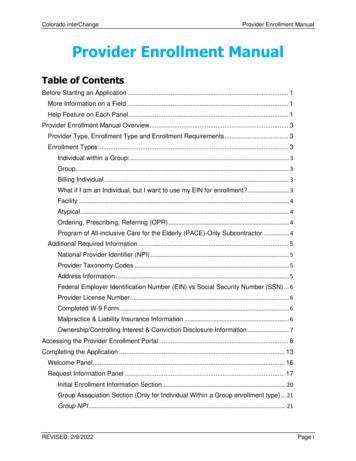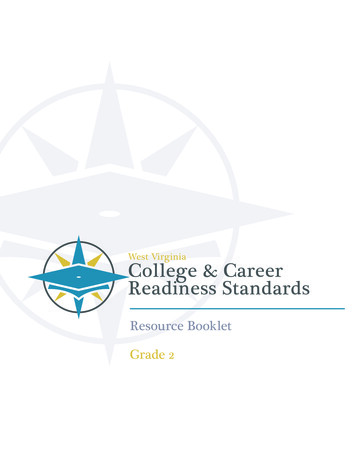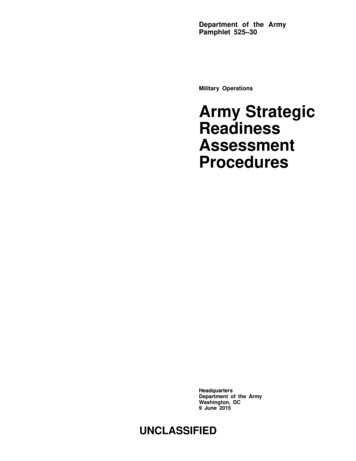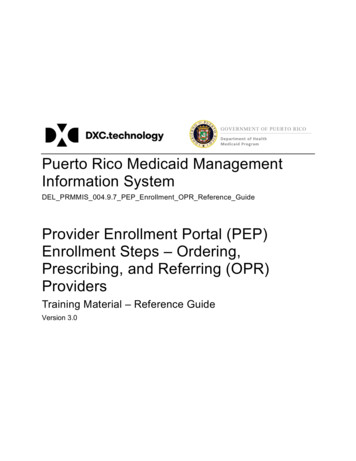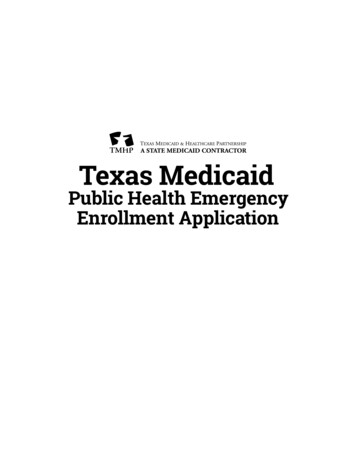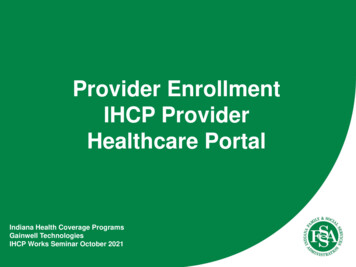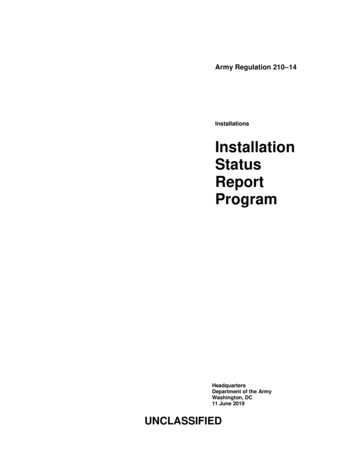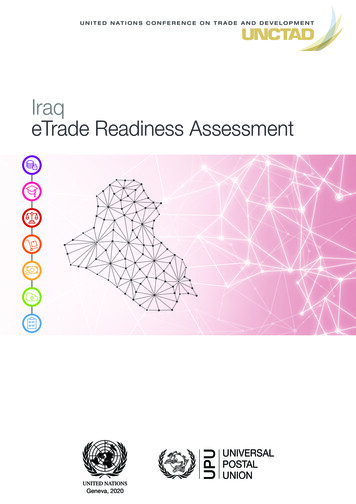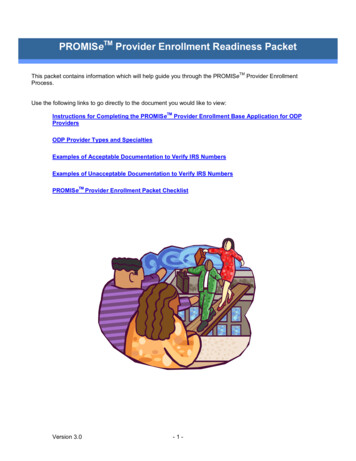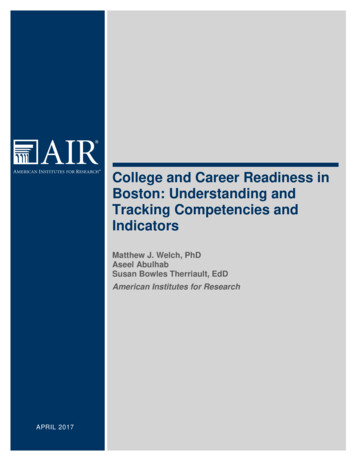
Transcription
1URBAN EDUCATIONEDUCATION INSTITUTEINSTITUTEURBANCOLLEGE READINESS,ENROLLMENT PROFILES,AND PATHWAYSINTO THE UNIVERSITY OF TEXAS AT SAN ANTONIO:A QUANTITATIVE ANALYSIS OF COLLEGE READINESSAND ENROLLMENT PATTERNS IN BEXAR COUNTYBy Dr. Michael U. VillarrealNovemberApril 2021 2020
2ABOUT THEURBAN EDUCATION INSTITUTEOUR MISSIONThe Urban Education Institute at UTSA produces scientific research to raise educationalattainment, advance economic mobility, and help people achieve their potential in thegreater San Antonio region.We pursue our mission by (1) producing rigorous and actionable analysis that supportseducation policymaking, program implementation, and philanthropic giving; (2)convening community leaders to address entrenched challenges that harm educationand human development; and (3) training the next generation of social scientists andeducators to address education challenges through inquiry, analysis, and discovery.
3TABLE OF CONTENTSINTRODUCTION9KEY FINDINGS12STUDY POPULATION16OBJECTIVE 1: BEXAR COUNTY HIGH SCHOOL GRADUATE PROFILES18Sociodemographic CharacteristicsHigh SchoolsComparative Analysis of Three GroupsCollege ReadinessSubgroups by High School1826283339OBJECTIVE 2: PATHWAYS INTO UTSA & HIGHER EDUCATIONConceptual FrameworkPathways Findings464649REFERENCES54APPENDIX 1: DETAILED TABLES56APPENDIX 2: METHODOLOGY USED FOR OBJECTIVE 261APPENDIX 3: TREND ANALYSIS OF POSTSECONDARY ENROLLMENT63APPENDIX 4: PATHWAY ANALYSIS OF ALL HIGH SCHOOL GRADUATES66APPENDIX 5: PATHWAY ANALYSIS OF UTSA ELIGIBLE82
4LIST OF TABLESTABLE 1Study Sample by Year of High School Entry19TABLE 2Actual and Projected Population of Bexar County Residents Ages 18 to 2219TABLE A1All Public High School Graduates of Bexar County and the UTSA Eligible, UTSA56Enrolled, and Undermatched by High School-Entry Cohort, 2006 to 2015TABLE A2Student Sociodemographic Characteristics for All Public High School Graduates of57Bexar County and the UTSA Eligible, UTSA Enrolled, and UndermatchedTABLE A3Academic College Readiness Scores and Indicators for Public High School Graduates58of Bexar County and the UTSA Eligible, UTSA Enrolled, and UndermatchedTABLE A4High School Coursework for Public High School Graduates of Bexar County and the59UTSA Eligible, UTSA Enrolled, and UndermatchedTABLE A5Average Distribution by School of Bexar County High School Graduates and ThreeSubgroups: UTSA Eligible, UTSA Enrolled, & Undermatched, HS-Entry Cohorts 2006to 201560
5TABLE OF FIGURESFIGURE 1High School Graduates by Non-overlapping Race and Ethnic Categories20FIGURE 2Socioeconomic Indicators of High School Graduates21FIGURE 3Participation Rates of Five Types of Courses and Average Credit Earned Per Type25Excluding Non-participantsFIGURE 4Size of the 61 Bexar County High Schools’ Graduating Classes: Each blue bar27represents the number of students in a single high school graduating classFIGURE 5Average Size of three Categories of High School Graduates of Interest in Thousands28FIGURE 6High school graduates who were eligible for UTSA admissions, those who enrolled,29and those who were eligible but enrolled in a two-year college over a four-year collegeas a percent of all high school graduatesFIGURE 7Ethnic-Racial Attributes of UTSA Eligible, UTSA Enrolled and Undermatched30FIGURE 8Females as a Percent of UTSA Eligible, UTSA Enrolled, and Undermatched31FIGURE 9Socioeconomic Attributes of UTSA Eligible, UTSA Enrolled, and Undermatched32FIGURE 10Average SAT Scores of UTSA Eligible, UTSA Enrolled, and Undermatched33FIGURE 11TSI Certification in Reading, Writing, and Math of UTSA Eligible, UTSA Enrolled, and34UndermatchedFIGURE 12Performance on Eighth-grade Standardized Exams in Math and Reading of UTSA35Eligible, UTSA Enrolled, and UndermatchedFIGURE 13Completed Algebra by Eighth Grade for the UTSA Eligible, UTSA Enrolled, andUndermatched35
6FIGURE 14Participation in Advanced, and Early College and Career-Oriented Coursework for37UTSA Eligible, UTSA Enrolled, and UndermatchedFIGURE 15Average Credit Earned in Advanced, and Early College and Career-Oriented38Coursework for UTSA Eligible, UTSA Enrolled, and UndermatchedFIGURE 16Top and Bottom 10 High Schools in Percent of UTSA Eligible Relative to Graduating41Class Size, Graduation Years 2009 to 2018FIGURE 17Top and Bottom 10 High Schools in Percent of UTSA Enrolled Relative to UTSA42Eligible, Graduation Years 2009 to 2018FIGURE 18Top and Bottom 10 High Schools in Percent of Undermatched Relative to UTSA44Eligible, Graduation Years 2009 to 2018FIGURE 19A Conceptual Model of Postsecondary College and Employment Decision-Making47FIGURE 20Expected Postsecondary Outcomes including UTSA Enrollment in Year Following49High School, HS Entry Cohorts 2006-2015FIGURE 21Expected Postsecondary Outcomes in Year Following High School, HS Entry Cohorts502006-2015FIGURE 22Five Sources of UTSA’s Cumulative Enrollment of Local High School Graduates in51Years Five to EightFIGURE 23UTSA’s Cumulative Enrollment in Years 5 to 8 of Local High School Graduates Who51Were UTSA Eligible and All OthersFIGURE 24Expected Postsecondary Outcomes in Year Following High School of Students Who52Were Eligible for Automatic Admission into UTSA, HS Entry Cohorts 2006-2015FIGURE 25Five Sources of UTSA’s Cumulative Enrollment in Years Five to Eight of UTSA Eligible,Local High School Graduates Who Graduated in the Top 25% of their Graduating Classor Earned an 1100 SAT or Higher53
7FIGURE A1Postsecondary Enrollment in First Year Following High School, Bexar County 9th-65Grade Cohorts 1999-2017FIGURE A2UTSA Enrollment Pathways of Students who Started at UTSA Following High School67FIGURE A3UTSA Enrollment Pathway of Students who Started at a Community College68Following High SchoolFIGURE A4UTSA Enrollment Pathway of Students who Started at a Four-Year College Other Than70UTSA after High SchoolFIGURE A5UTSA Enrollment Pathways of Students who Worked & Did Not Enroll in College After71High SchoolFIGURE A6UTSA Enrollment Pathways of Students who Experienced NEET Following High73SchoolFIGURE A7UTSA Enrollment Pathways of Students who Started at UTSA After High School But75then Transferred to a Two-Year CollegeFIGURE A8UTSA Enrollment Pathway of Students who Started at a Four-Year College Other Than77UTSA Following High School and then Transferred to a Two-Year CollegeFIGURE A9UTSA Enrollment Pathways of Students who Worked & Did Not Enroll in College79Following High School, But Then Transferred to a Two-Year CollegeFIGURE A10UTSA Enrollment Pathways of Students who Experience NEET Following High81SchoolFIGURE A11UTSA Enrollment Pathways of UTSA Eligible Students who Started at UTSA83Following High SchoolFIGURE A12UTSA Enrollment Pathway of UTSA Eligible who Started at a Community College84Following High SchoolFIGURE A13UTSA Enrollment Pathway of UTSA Eligible who Started at a Four-Year College OtherThan UTSA Following High School86
8FIGURE A14UTSA Enrollment Pathways of UTSA Eligible who Worked & Did Not Enroll in College87Following High SchoolFIGURE A15UTSA Enrollment Pathways of UTSA Eligible who Experienced NEET Following High89SchoolFIGURE A16UTSA Enrollment Pathways of UTSA Eligible who Started at UTSA Following High90School But Then Transferred to a Two-Year CollegeFIGURE A17UTSA Enrollment Pathway of UTSA Eligible who Started at a Four-Year College Other92Than UTSA Following High School But Then Transferred to a Two-Year CollegeFIGURE A18UTSA Enrollment Pathways of UTSA Eligible who Worked & Did Not Enroll in College94Following High School But Then Transferred to a Two-Year CollegeFIGURE A19UTSA Enrollment Pathways of UTSA Eligible who Experienced NEET Following HighSchool But Then Transferred to a Two-Year College96
99INTRODUCTIONIn the Fall of 2020, Provost Kimberly Andrews Espy, Ph.D., of The Universityof Texas at San Antonio (UTSA), engaged the Urban Education Instituteat UTSA (UEI) to investigate college readiness and enrollment patterns ofhigh school students enrolled in Bexar County public schools. Her goalwas to inform ongoing efforts to advance college access to historicallyunderserved local school communities. This report is a product of thisresearch engagement.Dr. Villarreal, the primary investigator of this project, operationalized theProvost’s directive with advice from Lynn Barnes of Strategic Enrollmentand Dr. Steve Wilkerson of Institutional Research into the following tworesearch objectives:Objective 1. Produce a statistical profile of four groups of Bexar Countyhigh school graduates: (1) all graduates; (2) graduates who were eligiblefor guaranteed admission into UTSA; (3) graduates who directly enrolledin UTSA after high school; and (4) graduates who were eligible for UTSA’sguaranteed admissions but instead enrolled in a two-year college and not afour-year college in their first year following high school.
1010Objective 2. Estimate a model that predicts postsecondary enrollmentpatterns of Bexar County high school graduates during the first four yearsafter high school as a function of five mutually exclusive, postsecondaryevents: (1) enrollment in UTSA, (2) enrollment in a four-year college otherthan UTSA, (3) enrollment in a two-year college only, (4) employment andno college enrollment, or (5) no participation in employment, education, ortraining (NEET).Researching Objective 1 helped establish a broad understanding of highschool graduates by answering numerous questions: How many studentsgraduate from public high schools in Bexar County? Is this number growingor declining? What are graduates’ sociodemographic characteristics? Howdo high school student bodies differ by their levels of college readinessand enrollment? Answers to these questions contextualized college-goingpatterns in Bexar County.
1111In addition to answering the above questions, this study also shone lighton UTSA recruitment opportunities by comparing high school graduateswho were eligible for guaranteed admission into UTSA in their first yearfollowing high school (referred to as “UTSA Eligible” throughout this report)with graduates who enrolled in UTSA in their first year following high school(referred to as “UTSA Enrolled” throughout this report). Moreover, thisanalysis was disaggregated by high school, thereby identifying the averagesize and yield of college-ready and college-enrolled students for each highschool.The study also examined a particular type of undermatching, when studentsenrolled in a two-year college despite a class rank or SAT/ACT score thatwould have afforded them guaranteed admissions into UTSA and manyother regional public four-year colleges. These students are a subset of UTSAEligible and are referred to as “Undermatched” throughout this report. TheUndermatched represent a significant recruitment opportunity for UTSA.Investigating Objective 2 identified the most traveled pathways into UTSAand answered the following questions: How many students transferredto UTSA after one, two, and three years in community college? How largewas the population of students who left San Antonio to earn a bachelor’sdegree and then returned home to enroll in UTSA? What was the likelihoodof enrolling in UTSA after sitting out of school for one, two, and three years?How did other four-year colleges compare to two-year colleges in beinga source of transfer students into UTSA? This analysis answered thesequestions and more, shedding light on the timing of college-going choicesand sources of enrollment.
12KEY FINDINGSObjective 1: Bexar County High School Graduate ProfilesThe number of public high school graduates in Bexar County grew each year of thestudy by an average of 3.3%, 2009 to 2018. However, growth slowed in the second halfof the study period. This pattern of slowing population growth resembles demographicprojections of Bexar County residents in the age group of 18 to 22 from 2010 to 2030,suggesting that there will be greater competition between local colleges for local highschool graduates unless the share of college-ready high school graduates increases.The sociodemographic attributes of local public high school graduates as a wholereflect a population with a composition largely defined as Latina/o (66.6%),economically disadvantaged (53.1%), and first-generation college-going (66.1%).A majority of high school graduates were found to participate in early collegecoursework (either Advanced Placement “AP” or International Baccalaureate “IB”or dual credit “DC”); however, their depth of engagement as measured by number ofcourses credits earned in these classes varied considerably.In terms of academic preparation, high school graduates pursuing college degreeswere most stymied by their lack of mathematical preparation. Before they wereallowed to enroll in college-level math courses, 35% required remediation in math.
13Graduates were concentrated in a fraction of the 61 high schools in the study sample.A majority of students graduated from 15 high schools and 68% graduated from 22 highschools. Nearly all of these large schools were located in two school districts, NorthsideISD and North East ISD.From 2009 to 2018, the growth rate of local high school graduates enrolling in UTSA(5.1%) outpaced the overall high school graduate population’s growth rate (3.3%),suggesting that UTSA has improved its ability to recruit from local high schools.For the average high school, 12.3% of their UTSA Eligible graduates enrolled in atwo-year college and not a four-year college. This figure ranged from 15% to 26% in 18mid- to large-sized, comprehensive high schools. Nearly all of these schools were locatedinside Loop 410 or south of downtown San Antonio.Female high school graduates were overrepresented in the UTSA Eligible andUndermatched subgroups at 56% and 61%, respectively.Latina/o high school graduates were underrepresented in both the UTSA Eligible(53.5%) and UTSA Enrolled (58.4%) but overrepresented in the Undermatchedsubgroup (69.2%).Black high school graduates were also underrepresented in both the UTSA Eligible(6.2%) and UTSA Enrolled (5.4%) but not overrepresented in the Undermatchedsubgroup (5.3%).
14 Students from low-income households were underrepresented in the UTSA Eligible(35.4%), UTSA Enrolled (37.0%), and Undermatched (50.8%) groups. Conversely,this meant they were overrepresented among students with lower levels of academicachievement and who did not continue their education beyond high school.A diverse set of college-readiness measures found that the UTSA Eligible graduatesdemonstrated the highest levels of academic preparedness based on standardizedtest scores and early college course credits earned (AP/IB and DC), closely followedby the UTSA Enrolled.Students in the Undermatched group exhibited lower levels of prior academicachievement as compared to the UTSA Eligible and UTSA Enrolled graduates, buthad the strongest participation in career-oriented high school coursework.Objective 2: Pathways into UTSA & Higher EducationOf Bexar County’s average high school graduation cohort, 7.3% enrolled in UTSA intheir first year following high school. Of the UTSA Eligible graduates, 23.6% enrolled inUTSA in their first year following high school.Enrolling in UTSA immediately after high school was the dominant pathway intoenrolling and staying enrolled in UTSA. It represented 75.4% of UTSA’s enrollmentof local graduates during the first four years following high school. This figure rose to85.8% for the UTSA Eligible.
15The next most popular pathway into UTSA involved students passing through twoyear colleges before enrolling in UTSA. For the first four years following high school,this pathway represented 16.9% of UTSA’s enrollment for all local graduates. This figurefell to 6.6% for the UTSA Eligible.A third popular pathway into UTSA began with enrollment in a four-year collegeother than UTSA immediately following high school and then led to transferring toUTSA. This pathway represented 6% of UTSA’s enrollment of local graduates and 6%of the UTSA Eligible — making four-year colleges a source of UTSA Eligible studentsapproximately equal to two-year colleges.Bexar County high school students who took a year off from school after high schoolcomprised less than 1.6% of UTSA’s enrollment of local graduates during the firstfour years following high school.
16STUDY POPULATIONThis study examined the college readiness and enrollment patterns of Bexar Countypublic high school graduates. The study sample was created from educationaland workforce administrative data for Bexar County high school graduates whoentered high school between year-end 2006 to 2015 (all years in this report are yearend, from September 1 to August 31). These 10 cohorts excluded students enrolledin alternative education programs during their senior years, a reduction of 0.8% ofthe total high school senior population. The study sample was further reduced byexcluding students enrolled in schools that no longer exist. These schools were allcharter schools and accounted for 0.4% of the total high school senior population.Finally, schools that served less than 16 students during the study period wereexcluded to be able to report statistics at the school level and comply with theFamily Educational Rights and Privacy Act (FERPA). A total of 10 students wereexcluded for this reason.In summary, the study sample represented nearly 99% of all Bexar County highschool graduates who entered high school in 2006 to 2015. The size of the studysample equaled 161,727 students who graduated from 61 different Bexar Countypublic high schools – both traditional and charter.
17The study relied on eight years of annual, longitudinal data to describe a student’shigh school and postsecondary journey. Data on each high school graduate wasgathered from the first year they entered high school (referred to as “year one”)to their expected high school graduation date four years later (referred to as “yearfour”). Data was also collected on their educational and employment experiencesin the first year following high school (referred to as “year five”) to the fourth yearfollowing high school (referred to as “year eight”).
18OBJECTIVE 1:BEXAR COUNTY HIGH SCHOOL GRADUATE PROFILESSOCIODEMOGRAPHIC CHARACTERISTICSSize. The number of public high school graduates grew each year during the studyperiod. As shown in Table 1, 13,525 public high school graduates started their highschool journey in 2006. Ten years later, the numbers grew to 18,151. A growing highschool graduate population has meant a growing local client base for local collegeslike UTSA. However, the growth rate of high school graduate was not constant.The annual growth of high school graduates began to slow in the second half of thestudy period. In the first half of the study period, annual growth rates averaged 4.6%.In the second half, the growth rate lowered to an average of 2.3%. This pattern ofslowing population growth resembles demographic projections of Bexar Countyresidents in the age group of 18 to 22 from 2010 to 2030, as shown in Table 2 (TexasDemographic Center, 2021), suggesting that there will be greater competitionbetween local colleges for local high school graduates unless the share of collegeready high school graduates improves.Moreover, this pattern of slowing population growth in Bexar County will be takingplace within a national context of negative growth rates. The U.S. population of highschool students is expected to decline. What this means for local and state colleges isgreater competition from out-of-state colleges as they search for qualified studentsto fill their classrooms (US Census, 2017).
19TABLE 1: STUDY SAMPLE BY YEAR OF HIGH SCHOOL ENTRYCOHORTFREQUENCY % OF STUDY ,727100.0AverageGrowth RateTABLE 2: ACTUAL AND PROJECTED POPULATIONOF BEXAR COUNTY RESIDENTS AGES 18-22Source: TexasDemographic Center.2018 Texas PopulationProjections Data Tool.YEARTOTAL POP FIVE-YEAR GROWTH 37.4%2045212,3035.2%2050219,6083.4%GROWTH RATE7.6%3.6%4.0%3.3%1.7%2.2%4.1%0.7%2.8%3.3%
20Race & Ethnicity. Bexar County public high school graduates were predominatelyLatina/o, as shown in Figure 2. High school graduates were composed of Latina/o,White, Black and Asian students at respective shares of 66.6%, 21.8%, 7.9%, and 2.4%. 1Students who identified as another ethnic group including Native American, PacificIslander, or Native Alaskan were categorized as Other and represented 1.4% of publichigh school graduates.FIGURE 1: HIGH SCHOOL GRADUATES BY NON-OVERLAPPINGRACE & ETHNIC CATEGORIESNote: White representsnon-Latina/o Whitestudents.Gender. Female students made up half of all public high school graduates.Socioeconomics. This study used three measures to describe the socioeconomicstatus of high school graduates, as shown in Figure 3. First, students were identifiedas economically disadvantaged based on their eligibility to enroll in the federalfree or reduced lunch program. Of all high school graduates, 53% were consideredeconomically disadvantaged. Second, students who changed schools during theirhigh school years were also identified. In San Antonio, school mobility has been1. This study relied on a categorization of race & ethnicity that made Latina/o, White, Black, Asian and Other non-overlapping.Students who identified as Latina/o were categorized as Latina/o. Students identified as White, Black, Asian, or Other were allnon-Latina/o.
21found to be highly correlated with poverty and family instability (Villarreal, 2020).Of all high school graduates, 15.4% changed schools during high school. Finally, firstgeneration college students (i.e., parents have not earned a college degree) made up66.1% of high school graduates who apply to a four-year college.2FIGURE 2: SOCIOECONOMIC INDICATORS OF HIGH SCHOOL GRADUATESNote: First-generationcollege-going representsstudents without aparent who earned anAssociate or Bachelor’sdegree. Economicallydisadvantaged wasdetermined by free-orreduced lunch eligibility.Overall, the demographics of local public high school students reflected a growingpopulation, whose composition is largely defined as Latina/o, economicallydisadvantaged, and first-generation college-going students.College Readiness. Becoming ready for college is the first transition in a student’scollege journey. The existing literature defines college readiness as a function ofstudent aspirations, expectations, and academic preparations for college (Perna &Thomas, 2006). This study used four sets of variables to operationalize the conceptof college readiness: completion of a college entrance exam, Texas Success Initiativecertification, performance on state-mandated, eighth-grade exams, and high schoolcoursework.2. Parent education is only identified in four-year college application data.
22SAT Scores. Taking a college entrance exam (e.g., SAT or ACT) signaled a student’slevel of college aspirations and planning since it was an application requirement for9 out of 10 four-year colleges in the United States during the study period (Milewski& Camara, 2002). Performance on an entrance exam predict a student’s academicsuccess in college, though its correlational strength has been found to be weakerfor non-White students (Nettles et al., 1986). While Texas’ statewide longitudinaldata system collects this information, it only collects college entrance exam scoresfor students who applied to a four-year college. Consequently, descriptive statisticsrelated to entrance exams were limited to those who applied to a four-year college.Public high school graduates who applied to a four-year college had an averageSAT score (including ACT scores converted to SAT equivalent scores) equal to 915, apercentile ranking of 20% based on 2016 results (SD 364).Texas Success Initiative (TSI) certification. In 2003, the Texas Legislature createdan accountability system with the goal of ensuring that high school graduateswere adequately prepared for college-level coursework by diverting students todevelopmental or remedial coursework who were identified as needing remediation.TSI sets rules that define eligibility to earn college credit toward a college degree.Eligibility is determined in three subjects: math, reading, and writing. Studentsmeet eligibility requirements by meeting a minimum threshold score per subject.Students can meet these minimum standards based on their performance ondifferent standardized exams (e.g., SAT, ACT, TSI, and state-mandated end-of-courseexams).
23Of high school graduates who enrolled in college, most but not all met TSI standards.Prior to their first year in college, high school graduates were TSI certified inreading, writing, and math at rates of 73.4%, 77.6%, and 64.8%. As a group, highschool graduates pursuing a college degree were most stymied by their lack ofmathematical preparation. Before enrolling in a college-level math course, 35%required remediation in math. This figure was 27% for reading and 22% for writing.Eighth-Grade Academics. Performance on state-mandated exams in eighth gradehave been found to predict postsecondary enrollment and degree completion (Lee &Villarreal, 2021). This study used standardized eighth grade reading and math examscores (i.e., z-scores; the original score is reduced by the average score and dividedby the standard deviation) as an additional description of academic readiness. (Bydefinition, a Z-score of 0 represents an average score. A negative z-scores is belowaverage; and a positive z-scores is above average.)High school graduates of Bexar County earned a reading and math score justabove average (M 0.05, SD 0.91). This more positive average and slightly tighterdistribution is likely due to lower performing students dropping out of school beforehigh school graduation. Furthermore, the percent who completed Algebra by eighthgrade equaled 12%.High School Coursework. While a student’s high school career consists of manydifferent types of experiences, coursework is the primary activity of schools (Barr& Dreeben, 1983). Students select or are directed to enroll in courses that vary byrigor, subject, and college and career orientation. A minimum number of courses arerequired to complete a high school diploma, but students exceed this minimum byvarying degrees. The type and amount of course credits earned represent rich datato understand the academic preparation of students.
24This study analyzed high school coursework patterns using five types of courses: (1)advanced, (2) dual credit, (3) Advanced Placement (AP) or International Baccalaureate(IB), (4) career & technology education (CTE), and (5) CTE dual credit. Advancedhigh school courses were those identified by TEA to be more rigorous than typicalcourses and whose credit only applied to a high school diploma. Dual credit coursesrepresented college courses that allowed a student to simultaneously earn credittoward a high school diploma and a college degree. Variables that measure AP andIB course work were combined because IB acted as a substitute to AP in the veryfew schools that offered IB. Courses identified as CTE aimed to expose students tocareers and develop applied, marketable skills within specific career fields. CTE dualcredit represented CTE courses that build toward a vocational certificate typicallyoffered by two-year colleges.
25Most high school graduates earned at least one advanced high school credit (M 67.3%), while a slim majority earned AP/IB course credit (M 50.7%) and fewerearned dual credit (M 20.0%). Nearly every student earned at least one CTE coursecredit (M 94.7%), but very few earned CTE dual credit (M 5.3%).The above participation rates describe a high school graduate’s likelihood ofparticipating in a given type of course. Alternatively, number of credits earneddescribes depth of participation. In this regard, there was significant variation incredits earned, particularly for students enrolled in early college coursework (AP/IB and DC). The average student who participated in advanced high-school-onlycoursework earned 1.5 credits (SD 0.88). The average AP/IB student earned 3.9credits (SD 2.8). The average dual credit student earned 2.6 (SD 2.4). Finally, theaverage CTE and Dual Credit CTE students earned 4.0 (SD 2.2) and 1.2 credits (SD 0.6), respectively.FIGURE 3: PARTICIPATION RATES OF FIVE TYPES OF COURSESAND AVERAGE CREDIT EARNED PER TYPE, EXCLUDING NON-PARTICIPANTSNote: First-generationcollege-going representsstudents without aparent who earned anAssociate or Bachelor’sdegree. Economicallydisadvantaged wasdetermined by free-orreduced lunch eligibility.
26HIGH SCHOOLSThe size of graduating classes varied across Bexar County’s 61 public high schools,as shown in Figure 4. High schools appear to cluster by size of graduating class intothree groups: large schools with graduating classes larger than 400 (22 schools),mid-sized schools with 200 to 400 graduates (13 schools), and small schools withless than 200 graduates (26 schools). A majority of students graduated from 15 largehigh schools and 68% graduated from 22 mid- to large-sized high schools. Nearly allof these schools were located in two suburban school districts, Northside ISD andNorth East ISD.
27Overall, the largest schools were more likely to be found in the northern, suburbanparts of Bexar County, which are above average in property wealth and residentswho identify as White. The smallest schools were nearly all public schools of choice:open-enrollment charter schools, charter schools created by school districts, ormagnet schools. The mid-sized schools generally represented older, inner-city orsouthside, comprehensive high schools, which graduated pred
at UTSA (UEI) to investigate college readiness and enrollment patterns of high school students enrolled in Bexar County public schools. Her goal was to inform ongoing efforts to advance college access to historically underserved local school communities. This report is a product of this research engagement.
